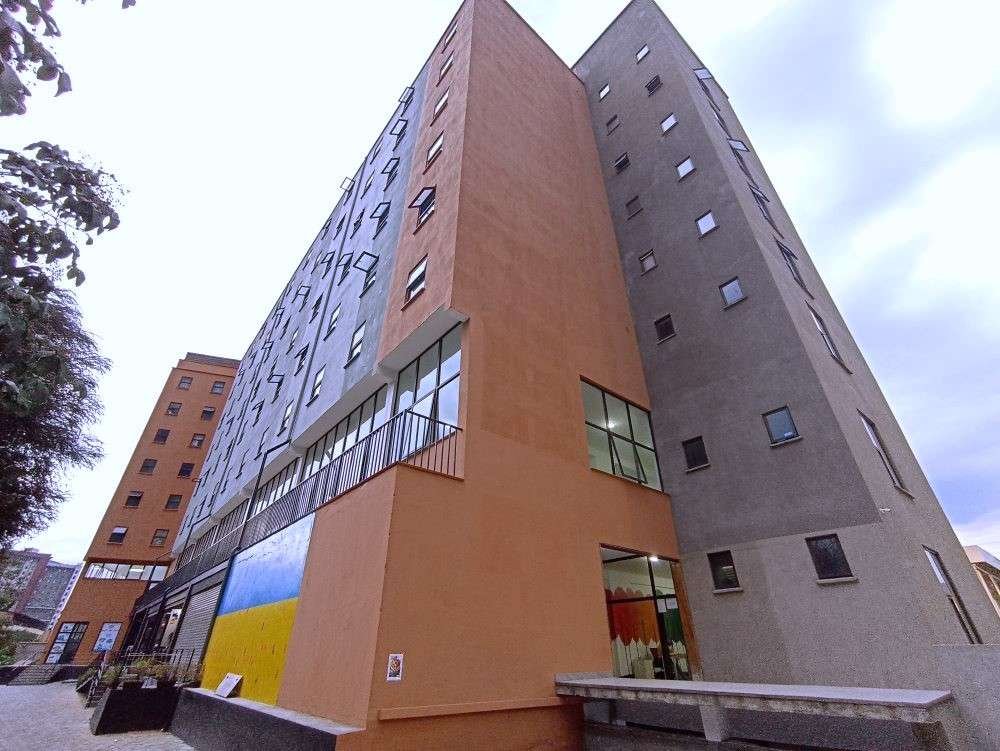Green construction scaled to tackle small- and large-scale projects. Anywhere.

For us, finding sustainable construction solutions is more than fancy words. It’s a serious driver of added value and cost savings over time.
Design-Build guide: procurement, contracts and project execution
The Design-Build method is an unmatched driver of innovation and best-value solutions in commercial construction. Learn how to procure Design-Build services and manage project execution to reap and maximize its many benefits.
Design-Build
Rapid delivery. Total team coordination.
A simple approach to construction. A team working together from start to finish in open communication and purposeful collaboration to deliver otherwise unachievable results. It’s the notion that when owners sit at the same table with architects, builders, engineers and estimators, great ideas are born. And the way is paved for creative solutions to take hold, resulting in costs minimized, schedules streamlined and efficiencies realized.
What is Design-Build?
Design-Build is a construction delivery method that provides owners with a single point of contact for both the design and construction phases of a project. One entity holds single-source responsibility and contractual risk for every aspect of a build — from estimation, assessments and pre-construction to architecture, schematics, engineering, subcontracting, construction and post-construction. This entity, the Design-Builder, manages all contracts with companies, such as subcontractors, equipment vendors and materials providers.

Unlike in other construction methods, owners contract only with the Design-Builder. In the two other primary construction methods used today — construction management and general contracting (also known as design-bid-build) — owners contract with different entities for architectural design and construction. Since Design-Build brings together all elements of a project, architects work in coordination with other members of the project team. In other methods, architectural design is completed separately, sometimes resulting in unforeseen costs and delays during the construction process. But Design-Build allows your project team to provide insights into the costs and constructability of different designs. The end result is a sound design, a budget defined and a schedule streamlined. It ensures business goals are met.
The Design-Build process
The Design-Build process has five main phases:
- Selecting a Design-Builder
- Pre-construction assessments
- Architectural design
- Construction
- Post-construction
But unlike other construction methods, the phases overlap. All team members collaborate throughout the process to provide rapid project delivery.
Selecting a Design-Builder
The Design-Build process begins when you select your Design-Builder. In other methods, you would start by selecting an architect. To limit the potential risks associated with having one entity design and construct your facility, you may have a competitive bidding process for Design-Builders.
Because Design-Builders aim to find you savings throughout design and construction, you’ll benefit from using a qualifications-based selection. That means you select the Design-Builder with the best credentials, experience, expertise and team. Alternatively, you can use a best-value selection method, in which you select a Design-Builder based on a combination of estimated price and added value in addition to experience, expertise and credentials. Our recommendation is to avoid using a hard low-bid selection process. Why? Design-Builders deliver the best value by evaluating budget solutions early in the design process and by creating continuous price estimates as the design progresses. Limiting your prospective builders to hard cost bids before they have a chance to get into the project can lead to misleading and uncertain estimates. Even worse, it can mean a project that doesn’t deliver what you need.
Pre-construction and building value engineering into design
The pre-construction phase of a project is crucial, setting the course for a successful job. It includes business and financial assessments, in which your Design-Builder’s pre-construction staff learn about your business, industry, goals, vision, financial realities and current and future facility needs.
Concurrently, architects and engineers begin architectural, mechanical and electrical system assessments and review any existing floor plans, fire and smoke preparations, interior room finishes and structural systems. While the design team gathers critical information, surveyors perform a field assessment of your jobsite to ready it for construction. If you’re improving your current space, your Design-Builder will assess your facility to identify areas of need. These assessments define key parameters like codes, compliance requirements, topography, the area’s weather characteristics, usable on-site natural resources and more.
With all the key information in mind, your project team partners with you to identify the right facility, design and construction program to help you achieve your goals within your budget and time constraints. The scope of your project is set, and creative solutions can take shape to help you realize your vision.
Architectural design and planning
Next, architectural design begins in earnest and represents the best opportunity to capture value in your project. After all, architectural design isn’t just about appearance. It’s a blend of form and function where strategy, vision, aesthetics and technology come together as a complete design that should drive your project to success.
Strategic architectural design: how to meet business goals and maximize ROI
Design isn’t just art. It’s a blend of strategy, problem solving and vision — form and function coming together to create facilities that meet business needs and improve operations. Read more about our preconstruction phase.
Construction
Following architectural design, you’ll save time, as you won’t need a second bid phase to select a contractor. In fact, your Design-Builder will start readying your jobsite while design progresses, and elements of construction can begin during the design phase. By overlapping construction and design, your project team can deliver a timely build that makes aggressive schedules possible. You’ll still have a construction team, specialty subcontractors, materials vendors and all the same quality standards as you would in other methods. But the job will get done more quickly, to a clearly defined scope with total accountability.

Benefits of Design-Build
Design-Build offers many unique benefits and advantages that other construction methods simply don’t deliver. It’s why we prefer Design-Build. Some of the biggest benefits of Design-Build are rapid delivery, a smooth process, better solutions and better communication.
Rapid delivery
Design-Build offers rapid delivery because design and construction happen concurrently and because there’s only one selection phase instead of two. The delivery method turns otherwise impossible timeframes into reality.
Smooth process
Time and again, Design-Build reliably equates to headaches eliminated, teams collaborating and owners pleased. The single-source responsibility afforded by Design-Build means there’s no conflicting recommendations from contractor and architect. Instead, one entity has total accountability for any and all construction and design elements. Owners know where the buck stops, and the way is paved for a smooth owner experience.
Better solutions and better value
In Design-Build, there’s no need to limit solutions to traditional ideas. So teams are only limited by what’s right for the project. As ideas come to the table, teams work as one unit to analyze them, in full transparency, so owners are assured of getting the best materials, schedule, design and more. This innovative process makes it possible for owners to see more options, make better-informed decisions and realize a better value.
Better communication and fewer problems
Delivering a successful Design-Build project requires open collaboration between all team members. Creating a team-oriented approach promotes high levels of communication and transparency, both imperative to the success of any project. It allows owners to share their vision with the team, and align the interests of the stakeholders. The team-oriented approach also provides the collaborative effort necessary to evaluate the project’s objectives, assess schedules and analyze opportunities as the project progresses. As a team, no other group is better qualified to align the owner’s vision with the project’s goals and objectives.
Design-Build facilitates it. All team members stay on the same page because everyone is working under one contract. And owners are kept up to date by a set contact from the Design-Builder. As a result, Design-Build is well suited for the most complex jobs, simplifying them so owners realize better quality, and require fewer variations.
Design-Build cost savings
Due to its efficiency, Design-Build often reduces construction costs for owners. This may come as a surprise, given that Design-Build projects lack the hard bid phase that general contracting affords. But building smart with Design-Build pays, reducing both real (accounting) costs and opportunity costs.
Design-Build reduces project costs
Numerous studies in the United States have shown that Design-Build projects are delivered faster, more cost-efficiently and with fewer variations that lead to unforeseen costs and schedule delays. In other words, Design-Build helps jobs get done on-time and on-budget.
Our Services
GENERAL CONTRACTING
GENERAL CONTRACTING
We have experienced site engineers to oversee the construction of your project, and our workers are keen to on details and good workmanship
INTERNATIONAL PROCUREMENT
Our process
-
Initial discussion
This is where you tell us what you’re looking to accomplish and why. No strings attached here. If after talking with us you feel we’re not the right fit, no worries.
-
Site visit
We want to see the site for ourselves. It’ll help us gather critical information needed for the next step.
-
Pre-construction
In pre-construction, we knuckle down and do the legwork. That includes engineering, drafting, estimating and working through the financials.
-
Construction
This is the best part. Your plans come to life in this stage.
-
Post-construction
We’ll do one last walkthrough to make sure everything’s crossed off the punch list and then hand you the keys.

